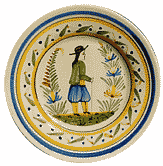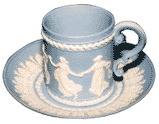Decorative arts expert Al Bagdade wrote the book on ceramics — literally. Your guide on everything from rare 18th-century porcelain to grandma’s tea set. Warman’s English & Continental Pottery & Porcelain
You may know it as “china,” but the ceramics category actually covers lots of territory, from functional and decorative porcelain to pottery (including earthenware and stoneware). Ceramic families differ primarily in the kind of clay that is used and in the temperature at which pieces are fired. Though certain aficionados may say otherwise, no subset of ceramics is inherently “better,” and each has its own considerable charm.
“Always buy the best piece you can afford,” advises Bagdade, who’s the author [with his wife Susan] of the authoritative Warman’s English & Continental Pottery & Porcelain. Whether your passion is tableware or decorative “cabinet pieces,” English soft paste porcelain or rustic brown stoneware, buy pieces based on personal taste, not as investments, adds Bagdade.


Porcelain
Porcelain is generally thinner, more delicate in appearance, and lighter in weight than pottery. Fired at a high temperature, porcelain is best known for its translucency and durability. In the firing process, the glaze fuses with and becomes part of the porcelain. “Bone china” is a type of porcelain containing calcinated animal bone.
Earthenware
Heavier, more porous, and folksier in appearance than porcelain, earthenware is glazed in a separate, less-uniform layer. Creamware is one of the better-known earthenware styles
Stoneware
Thicker-bodied, stoneware contains ground stone in its composition, and is often sealed with a thin salt glaze that can take on a pitted “orange peel” appearance. Common stonewares are basalt and jasperware.


Some points to consider when collecting ceramics:
Do the Homework
Gather tips from experts, go to museums, and try to see and handle someone else’s collection. Read articles and references: Good standards are Warman’s English & Continental Pottery & Porcelain (Susan and Al Bagdade), and Marks & Monograms on European and Oriental Pottery and Porcelain (William Chaffers).
Study a maker’s authentic marks, names, wording changes, and lesser-known styles. For instance, according to Wedgwood expert Bob Reichner, Wedgwood’s typeface has evolved over time, and pieces might be marked “England” or “Made in England.”
And pieces of the company’s hard-to-find tricolor and diceware are more highly prized than the familiar blue and white jasperware.
Condition
Avoid damaged pieces. Damage generally reduces value around 50 percent, unless a piece is very old or rare. Most very old pieces were actually used, and will have minor problems.
- Make sure the color is bright, crisp and uniform.
- Hold the piece to the light; run your hand along the rim to feel for chips or filled-in areas.
- Look closely where finials meet lids and handles meet cups.
- Don’t be taken in by catch phrases such as ‘age crack.’ A crack is a crack — the piece should be priced accordingly.
Authenticity
Similar marks can be deceiving, though companies may have formed legitimate partnerships over the years. Pieces of Wedgwood-Bentley (from a partnership in the 1700s) are quite valuable, but pieces by the Enoch Wedgwood company (with a unicorn mark) are less valuable, and unrelated to authentic Wedgwood.
Al Bagdade cautions, “There are a lot of forgeries out of there, and some of them are very good. For instance, some of the more popular patterns of Roseville are being reproduced. They are really tough to spot — you have to know to your Roseville.”
Patience
Contrary to the completeness freaks, Bagdade suggests, “There are good bargains out there in partial sets, if you’re willing to wait. You can do very well filling in pieces through antique shows, malls, replacement services and the Internet. After all, half the fun is the thrill of the hunt.”
Is your porcelain interest piqued?
Check out the outrageous, engaging history of porcelain’s entry into the Western world.
A passionate king, a mysterious formula, an imprisoned alchemist — the story of porcelain sounds more like Shakespearean drama. As revealed in Janet Gleeson‘s new book, the early 18th century mission by European royalty to secure the arcanum, or secret formula, for making fine porcelain has all of the intrigue, greed, and suspense of any Bard play.
References:
The Arcanum: The Extraordinary True Story, Warner Books, Inc.
Bagdade, Warman’s English & Continental Pottery & Porcelain.




